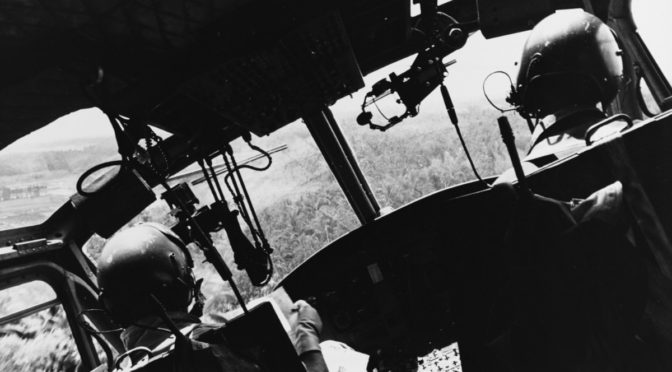By LCDR Andrew Poulin, USN
“Adaptability is the law which governs survival in war as in life.”–Sir Basil H. Liddell-Hart
“Scramble the Seawolves! Scramble the Seawolves!” The blaring call over the 1MC startles everyone onboard the small landing platform ship awake. Half-naked pilots and aircrewmen jump out of their racks, throw on their gear, and rush up the ladder-well to the flight deck. They strap into their helicopters, adrenaline pumping, sweat pouring down their foreheads. Power is applied, engines roar, rotors begin to turn. Within three minutes the first Huey lifts off the deck into the dark night, the second lifts about one minute later.1 The Seawolf crews have done this dozens of times this deployment, but each mission is different.
It’s only a seven-minute flight to the action – a small tributary in the middle of the Mekong Delta where a riverine patrol boat (PBR) has gotten into an unexpected firefight with Vietcong forces. There are no navaids to speak of, so the pilots navigate using visual checkpoints they memorized over several months of flying in the area. The two helicopters continue to pick their way through clouds as they arrive on station and see two Vietcong sampans firing intensely at the PBR. Both aircraft immediately begin to take anti-aircraft fire. The first aircraft unleashes a full salvo of 2.75-inch rockets at the sampans, sending them both to the bottom of the river. Dash Two follows shortly behind the lead aircraft and zeroes his focus on fire coming from the shoreline. His door gunners open fire and send hundreds of .50-caliber rounds downrange. The gunfire on the shore comes to an abrupt halt and, for now, the battle has ended. Once again, the Seawolves come to the rescue.
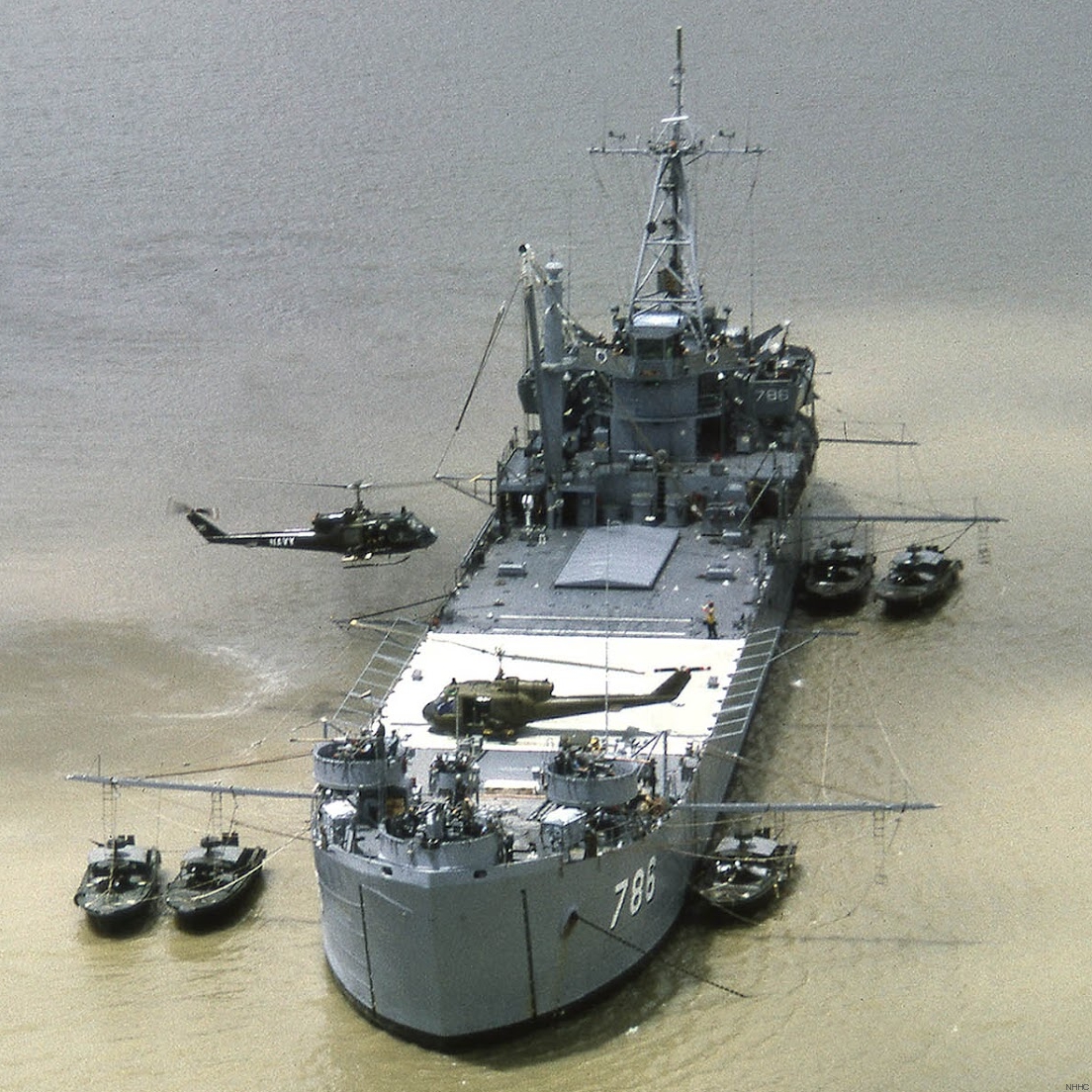
The defined “End State” of A Design for Maintaining Maritime Superiority 2.0 is, “A dominant naval force that produces outstanding leaders and teams, armed with the best equipment, that learn and adapt faster than our rivals.”2 When we think of great power competition, the country and military that adapts fastest to changing conditions – strategic, tactical, technological, cultural, or otherwise – will gain the advantage. Building on the Design, CNO Gilday’s FRAGO 01/2019 Warfighting End State focuses on “A Navy that is ready to win across the full range of military operations in competition, crisis, and contingency by persistently operating forward with agility and flexibility in an all-domain battlespace.”3 The U.S. Navy demonstrated this same adaptability in the mid-1960s in response to developments in Vietnam when it created Helicopter Attack Squadron (Light) 3 [HA(L)-3], “the Seawolves,” and this mindset is exactly what the Navy must foster today in order to be successful in any future conflict.
The 1960s, Vietnam, and the Seawolves
The 1960s in the United States was a time of great change, unrest, and upheaval. People were listening to The Beatles, watching the debut of Star Trek, and cheering during the first Super Bowl. There was progress and setbacks for civil rights, women’s equality, environmentalism, and national unity. The decade saw the first sit-in protests, landmark legislation like the Civil Rights Act, the publication of Silent Spring and The Feminine Mystique, but also the assassinations of President John F. Kennedy, Dr. Martin Luther King, Jr., and Robert F. Kennedy.
Meanwhile, the situation in Vietnam was deteriorating and the United States decided to increase its involvement. By mid-1965, U.S. troops were granted permission to go on the offensive in Vietnam.4 In August, Rear Admiral Norvell G. Ward, Chief of the Naval Advisory Group in Saigon, was given responsibility for Operation Market Time, a coastal surveillance operation designed to prevent the Vietcong from transporting any supplies from North Vietnam to the South.5 Ward immediately launched several studies to determine how to expand Market Time into the Mekong Delta and the treacherous Rung Sat Special Zone (RSSZ), called by some as the “forest of assassins.” His findings pointed to an enemy (the Vietcong) that was deeply embedded in the region and a partner (the Vietnamese Navy) that did not have the leadership, resources, or training to solve the problem. He therefore concluded that there was a clear need for the United States to get further involved in the Delta.6
The Mekong River stretches over 2,700 miles, winds through six countries, and drains over 313,000 square miles of land. It is the longest river in Southeast Asia and more than 60 million people depend on the Mekong region for their livelihoods.7 In the summer of 1965, U.S. Navy planners realized that although they had previously let naval riverine doctrine and tactics wither, conditions in Vietnam indicated it was exactly what they would have to reinvigorate to succeed. Their rudimentary doctrine at the time noted, “Where navigable waterways exist, and roads do not, or when roads are interdicted and hostile forces use navigable waterways to supplement or replace road movement, a doctrine and strategy of interdiction and control of waterways becomes decisive.”8
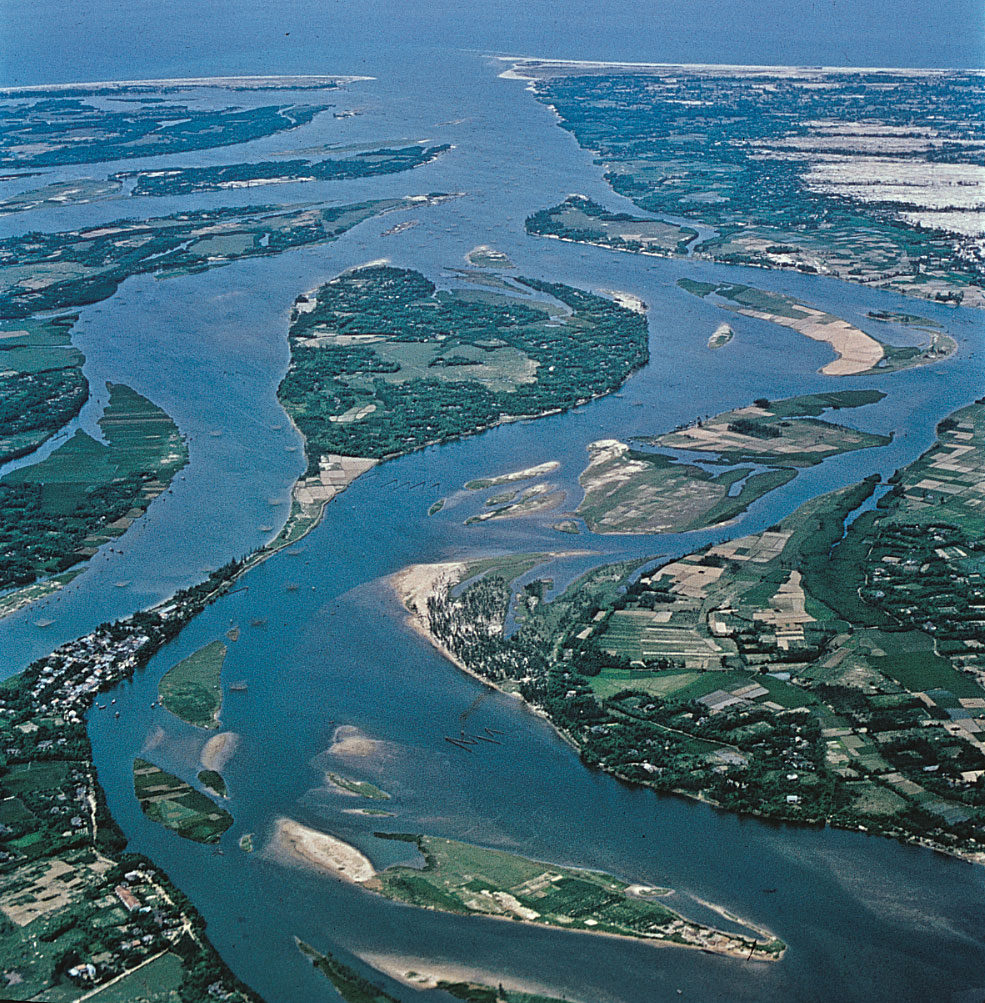
This led to Operation Game Warden and the official formation of the Navy’s River Patrol Force in December 1965, also known as Task Force 116.9 Rear Admiral Ward then set out to find helicopters that could fly close-air support for Game Warden. However, the Navy did not have anything that fit the bill. It did have SH-2 Seasprite and SH-3 Sea King helicopters – both of which were reliable platforms for ASW, SUW, and SAR missions, but were in no way optimized for close-air support or attack tasking. As a result, it was Army UH-1 Hueys that first filled this role for Game Warden. Nevertheless, senior defense officials including Rear Admiral Ward, recognized that ultimately it should be Navy helicopters supporting the Navy’s riverine operations.
Where other leaders gave up, Rear Admiral Ward, now Commander Naval Forces Vietnam, was persistent. He said that “I had been mulling over for a long time how to get navy helicopters to replace what we had. The navy had told me they didn’t have any available and couldn’t do anything to help me.” On his own initiative, Ward contacted Captain Chris Cagle, who was the Director of Aviation Programs for OP-05 (then the Office of the Deputy Chief of Naval Operations – Air Warfare). Ward asked Cagle if the Navy could supply pilots and aircrew from existing squadrons, if Ward provided the helicopters. Fortunately, Captain Cagle said yes.10Ward had his crews, but he still needed to ensure they had a ride to the fight.
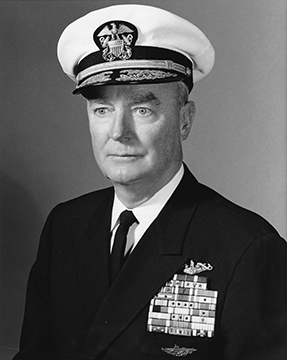
Initially, Helicopter Combat Support Squadron 1 (HC-1) was tasked with providing crews for four detachments to send to Vietnam, and it was these same detachments that were used to establish Helicopter Attack Squadron (Light) 3 on April 1, 1967. However, this stretched HC-1’s personnel to the outer limit, so the Navy decided to recruit top talent from all navy squadrons.12 “For the first time in history, navy helicopter pilots and crews would be flying attack missions in a close-up, and very deadly, combat environment…only volunteers were solicited from both officer and enlisted ranks. To nobody’s surprise, the response was enthusiastic. The volunteer list was filled almost immediately and, to the chagrin of other would-be gunship pilots, was temporarily closed.”13 Retired Navy Captain Brian Buzzell noted that pilots fresh out of flight school were warned that if they joined the Seawolves, “you are going to get shot at and maybe killed.”14 The volunteers that came forward were the true embodiment of the warrior ethos, and they were ready to get to work.
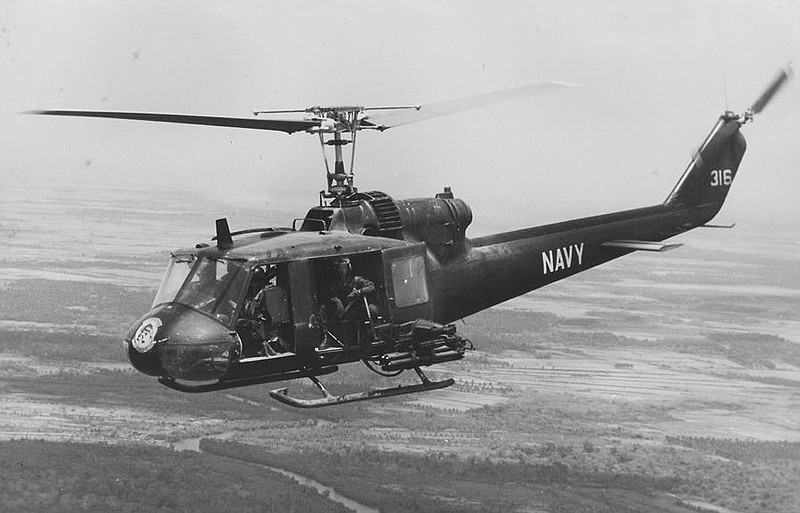
Training Development and Results
Because these navy crews were going to fly different aircraft, in a deadly combat zone, for a mission they had never before conducted, they needed significant training. At first, aircrew pre-deployment training was rudimentary – SERE school, physical training, and a weapon’s familiarization course. They would not fly the UH-1 Huey until they arrived in Vietnam where they were given familiarization flights in Saigon with the U.S. Army, followed by additional specialized training with the Army’s 197th Armed Helicopter Company.15 The Navy pilots brought a strong foundation of superb instrument training. In turn, the Army taught them the inner workings of flight lead formation tactics, close air support, and aerial gunnery. Within a few months, the Navy organized more comprehensive UH-1 gunship training stateside, first at Fort Benning, Georgia followed by Fort Rucker, Alabama. 16 Of course, the crews got plenty of “on-the-job training” as well. Commander Dick Barr, a retired Seawolves pilot, noted that, “In an average week two aircraft would shoot about a thousand rockets and a million rounds of 7.62…The door gunners would try to keep their brass inside the aircraft so it would not go out and hit the tail rotors. You’d come back and there would be six or seven inches of expended brass in the back.”17 It was a high optempo with a steep learning curve, but the extra practice ensured much greater success when it counted most.
Over the next five years the Seawolves flew over 130,000 combat hours in Vietnam, handled 1,530 MEDEVACs, delivered 37,000 passengers and 1,000,000 pounds of cargo, and inflicted several thousand enemy casualties.18 They earned 17,339 awards and decorations, making HA(L)-3 the most highly decorated squadron in U.S. naval history.19 They also built a fearless reputation among the people they served with in the Mekong Delta. In his book, Combat Swimmer: Memoirs of a Navy SEAL, retired Captain Robert Gormley said of the Seawolves, “I don’t know a single SEAL who operated in Vietnam that wasn’t saved by those guys at least once. They were the best helo crews I had ever seen. The Seawolf crews were real heroes.”20 The squadron’s actions had tangible results for Operation Game Warden. A post-war study from the Center for Naval Analyses concluded that:
- Game Warden interrupted enemy movement on traditional routes across the major Delta rivers.
- Enemy efforts to close the sea lanes to Saigon – a major Vietcong objective – were denied by U.S. and Vietnamese Navy forces.
- Game Warden secured many sections of the major Delta and Rung Sat Special Zone rivers for commercial use.
- Helicopters were essential to riverine operations in fire support, observation, and medical evacuation.21
By all accounts, the Seawolves punched above their weight class.
Don’t Be Afraid to Adapt
The Seawolves were successful for two main reasons: their people and organizational adaptability. For people, the Navy cast a wide net that attracted the best warriors from coast to coast who were motivated to serve their country and test their mettle in combat. Their strong bonds to each other and their commitment to always answer the call enabled them to surpass overwhelming odds again and again. It is an important reminder that as much as technology changes, warfighting is still a human-centered business. With respect to organizational adaptability, fortunately in this instance, there were enough senior navy and military leaders in the right positions who recognized the lack of navy close-air support helicopters in Vietnam was going to be a serious tactical shortfall and then acted swiftly to alter course. But it is also important to recognize there were plenty of navy leaders that were against establishing HA(L)-3. Recall the words of Rear Admiral Ward as he was searching for helicopters: “The navy had told me they didn’t have any available and couldn’t do anything to help me.”22 Like Rear Admiral Ward with the Seawolves, we should never be afraid to adapt to changing circumstances and pursue what we know to be right, even if that means altering the programs, equipment, or processes we hold most dear as an institution. As Basil H. Liddell-Hart noted, “Adaptability is the law which governs survival in war as in life.”23
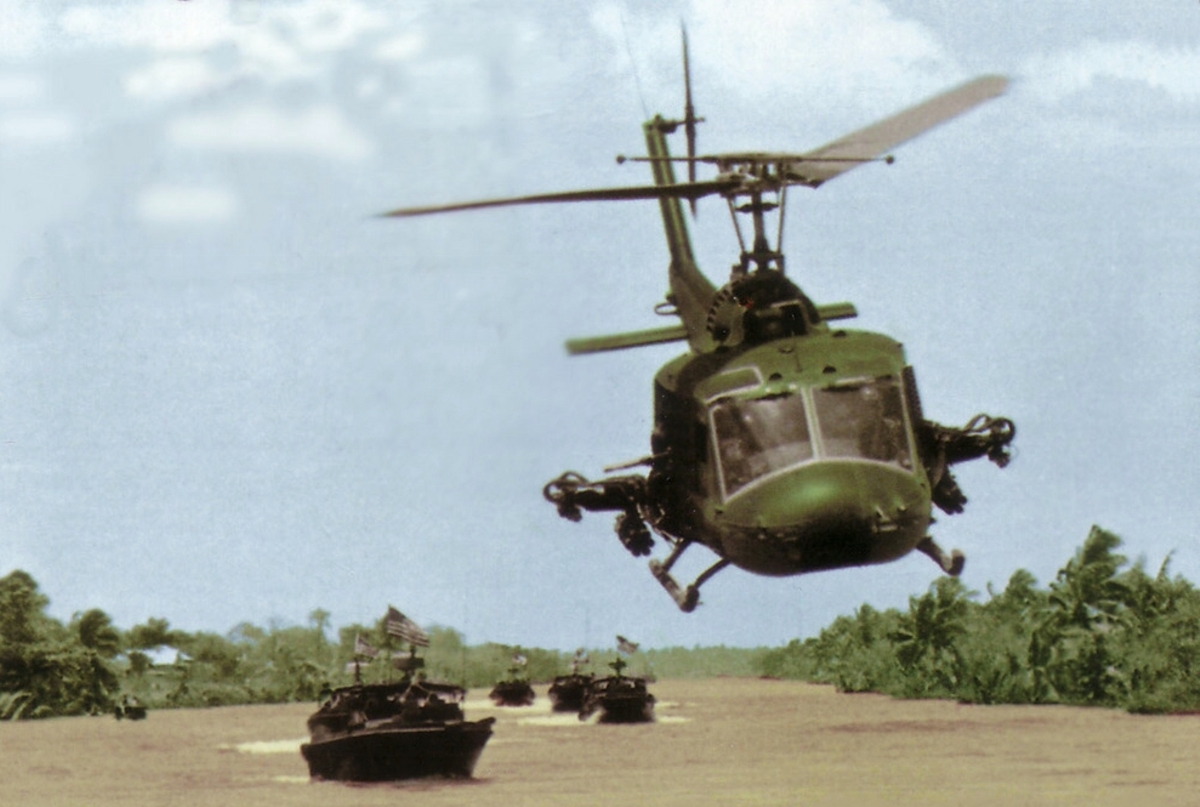
There are countless examples of militaries adapting in war, from Roman legions, to World War II radar and ASW advancements. Just like the U.S. Navy riverine patrol force of Vietnam, the Union had to make similar adaptations during the Civil War. Union military planners focused their naval strategy on three pillars: 1) blockade the Southern coast, 2) launch amphibious assaults to capture ports and strongholds, and 3) split the Confederacy along the Mississippi River and its tributaries.24 The problem however was that the Union Navy did not have any serviceable vessels that could fight on the burgeoning battlespace of America’s rivers. To win the war as fast as possible, the Union Navy would need to adapt and that is exactly what they did, just like the Navy did in Vietnam. The Union military created their own river patrol force by retrofitting old wooden sidewheel river boats and contracting new, low-draft “City Class” gunboats. The gunboats’ low draft came at the expense of a significant loss of armor, which increased their vulnerability, but a good enough solution now was much better than a perfect solution later. They hastily armed the gunboats with whatever guns they had available, including older 42-pounders offered by the Army, and 8-inch and 32-pounder Navy guns.25 It got the job done. The adaptation greatly aided the Union cause with victories at Fort Henry, Fort Donelson, Vicksburg, and many other critical locations, turning the tide of the Civil War in the Union’s favor.
We Must Adapt Faster than our Rivals
Today, the challenges are just as complex. Countries like China and Russia are increasingly blurring the line between military, economic, and political domains. General Valery Gerasimov, Chief of the General Staff of Russia’s Armed Forces, wrote:
The very “rules of war” have changed. The role of nonmilitary means of achieving political and strategic goals has grown, and, in many cases, they have exceeded the power of force of weapons in their effectiveness. The focus of applied methods of conflict has altered in the direction of the broad use of political, economic, informational, humanitarian, and other nonmilitary measures…26
In this vein, actions like the invasion of Crimea, land reclamation in the South China Sea, election meddling, and attempts to gain strategic access through economic blackmail and debt leveraging, all illustrate how countries can and will use every instrument at their disposal to gain an advantage.
A Design for Maintaining Maritime Superiority tells us that we must “learn and adapt faster than our rivals,” but our rivals are fast at work, too. For instance, China is predicted to have 360 battle force ships by the start of 2021 (compared to 297 for the U.S.), 400 by 2025, and 425 by 2030.27 Fueling this massive shipbuilding spree is a military budget that has increased by at least 1,000 percent since 1990.28 China now has the second-highest defense expenditure in the world with $266.4 billion, behind only the United States.29 The People’s Liberation Army (PLA) also understands the value that an adaptable force can bring. China’s 2019 Military White Paper directed China’s armed forces to “actively adapt to the new landscape of strategic competition, the new demands of national security, and new developments in modern warfare, so as to effectively fulfill their tasks and missions in the new era.”30 The PLA’s focus is on closing the relative power gap with the United States as fast as possible and enabling a military establishment that is adaptable to changing conditions.
Sun Tzu wrote that, “As water has no constant form, there are in war no constant conditions. And as water shapes its flow in accordance with the ground, so an army manages its victory in accordance with the situation of the enemy.”31 Any future conflict with an adversary will not unfold exactly how we think it will. Numerous variables may alter the battlespace to create something completely unrecognizable to what we previously planned. Plans may have to be altered, tweaked, or scrapped and replaced altogether. Prized programs may have to be changed, halted, or redirected. Our strategy may prove to rest on faulty assumptions that demand quick change. If we devise an out-of-the-box solution, we should seriously consider embracing it, just as the Navy did by creating the HA(L)-3 Seawolves in the 1960s.
We cannot prepare for everything, nor do we have the money and resources to do so. But we can prepare our people and our decision-makers to be flexible and agile enough to respond quickly to changing trends and landscapes. If we find ourselves in a war with a peer competitor, being smart enough to recognize when we need to change the game plan and brave enough to implement it will make all the difference. Just like Rear Admiral Ward and the Seawolves, we must never be afraid to adapt when the mission demands it.
Lieutenant Commander Andrew Poulin is a MH-60R pilot and a Navy political–military scholar. He is a graduate of the U.S. Naval Academy and Harvard University. Previously, he served as the President of CIMSEC and is currently a member of the CIMSEC Board of Directors. The opinions expressed above are those of the author alone and do not necessarily represent the official policy of the Department of the Navy or the Department of Defense.
Endnotes
1. Richard Knott, Fire From the Sky: Seawolf Gunships in the Mekong Delta, (Annapolis, MD: Naval Institute Press), 31.
2. ADM John Richardson, USN, “A Design for Maintaining Maritime Superiority, Version 2.0” (December 2018), https://www.navy.mil/navydata/people/cno/Richardson/Resource/Design_2.0.pdf.
3. ADM Michael Gilday, USN, “FRAGO 01/2019: A Design for Maintaining Maritime Superiority” (December 2019), https://www.navy.mil/cno/docs/CNO%20FRAGO%20012019.pdf.
4. PBS, “The Sixties: Moments in Time,” https://www.pbs.org/opb/thesixties/timeline/timeline_text.html.
5. Judith C. Erdheim, “Market Time – CRC 280,” Center for Naval Analyses (September 1975), https://www.history.navy.mil/research/library/online-reading-room/title-list-alphabetically/m/market-time-u-crc280.html#conclusions.
6. CDR S. A. Swarztrauber, USN, “River Patrol Relearned,” U.S. Naval Institute Proceedings Vol. 96, No. 5, (May 1970), https://www.usni.org/magazines/proceedings/1970/may/river-patrol-relearned.
7. Lewis Owen, Gilbert White, and Jeffrey Jacobs, “Mekong River,” Encyclopedia Britannica, https://www.britannica.com/place/Mekong-River.
8. CAPT Frederick Brazee, USN, “The Mobile Riverine Force, Mekong Delta, Republic of Vietnam, 16 February 1967-10 January 1968: Personal Experience of a Company Commander and Assistant Brigade S2,” U.S. Army Infantry School, Fort Benning, GA (23 September 1968), https://www.mrfa.org/wp-content/uploads/2016/06/BrazeeFrederick0E.CPT_-1.pdf.
9. Edward J. Marolda and R. Blake Dunnavent, “Combat at Close Quarters: Warfare on the Rivers and Canals of Vietnam,” Department of the Navy: Naval History and Heritage Command (2015).
10. Richard Knott, Fire From the Sky: Seawolf Gunships in the Mekong Delta, (Annapolis, MD: Naval Institute Press), 25.
11. Knott, Fire From the Sky, 24-25.
12. Navy Seawolves, “HC-1 Early History,” http://www.seawolf.org/history/hc1.asp.
13. Knott, Fire From the Sky, 26-27.
14. Hill Goodspeed, “I am a Sailor and a Seawolf,” U.S. Naval Institute Proceedings Vol. 33, No. 3, (June 2019), https://www.usni.org/magazines/naval-history-magazine/2019/june/i-am-sailor-and-seawolf.
15. John Darrell Sherwood, War in the Shallows: U.S. Navy Coastal and Riverine Warfare in Vietnam, 1965-1968, (Washington, D.C.: Naval History and Heritage Command), 125.
16. Sherwood, War in the Shallows, 126.
17. Goodspeed, “I am a Sailor and a Seawolf.”
18. Government Publishing Office, “Honoring Veterans of Helicopter Attack Light Squadron Three,” Congressional Record, Vol 156, No. 99, (June 29, 2010), https://www.govinfo.gov/content/pkg/CREC-2010-06-29/html/CREC-2010-06-29-pt1-PgH4918.htm.
19. Naval Helicopter Association Historical Society, “Naval Helicopter History Timeline: 400BC till 1940,” http://www.nhahistoricalsociety.org/index.php/naval-helicopter-history-timeline-new/.
20. Knott, Fire From the Sky, 192.
21. Victory Daniels and Judith C. Erdheim, “Game Warden – CRC 284,” Center for Naval Analyses, (January 1976), https://www.cna.org/CNA_files/PDF/CRC-284.pdf.
22.Knott, Fire From the Sky, 25.
23. Rick Baillergeon and John Sutherland, “Tactics 101 – Adaptation in War,” http://armchairgeneral.com/tactics-101-079-adaptation-in-war.htm.
24. Naval History and Heritage Command, “Riverine Warfare: The U.S. Navy’s Operations on Inland Waters,” https://www.history.navy.mil/content/history/nhhc/research/library/online-reading-room/title-list-alphabetically/r/riverine-warfare-us-navys-operations-inland-waters.html#middle.
25. Naval History and Heritage Command, “Riverine Warfare.”
26. General Valery Gerasimov, Russian Federation Armed Forces, “The Value of Science is in the Foresight,” Military-Industrial Kurier (27 February 2013) https://jmc.msu.edu/50th/download/21-conflict.pdf.
27. Congressional Research Service, “China Naval Modernization: Implications for U.S. Navy Capabilities – Background and Issues for Congress,” (May 21, 2020), https://fas.org/sgp/crs/row/RL33153.pdf.
28. Trading Economics, “China Military Expenditure,” https://tradingeconomics.com/china/military-expenditure.
29. Center for Strategic and International Studies, “China Power: What Does China Really Spend on Its Military?” https://chinapower.csis.org/military-spending/.
30. People’s Republic of China, “China’s National Defense in the New Era,” (July 2019), http://www.andrewerickson.com/2019/07/full-text-of-defense-white-paper-chinas-national-defense-in-the-new-era-english-chinese-versions/.
31. Lt Col Brian D. Dickerson, USAF, “Adaptability – A New Principle of War,” U.S. Army War College, Carlisle Barracks, PA, (July 2003), https://apps.dtic.mil/dtic/tr/fulltext/u2/a415124.pdf.
Featured Image: UH-1 Huey (HAL-3) – Vietnam War – October 1969 (Photo via Seaforces.org)

